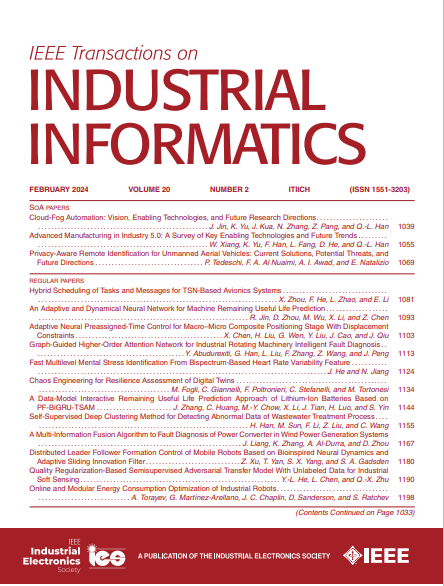A Novel Adaptive Mechanism-Data Fusion Graph Embedding Network for Fault Diagnosis
IF 9.9
1区 计算机科学
Q1 AUTOMATION & CONTROL SYSTEMS
引用次数: 0
Abstract
Due to the complex information transfer between devices, sensor signals exhibit complex interactions in large-scale industrial process, making fault diagnosis a challenging task. Despite the effectiveness of existing methods, models that lack the guidance of priori mechanisms are extremely data-dependent, and most methods ignore the fact that information interacts differently between strongly and weakly correlated variables. Therefore, a novel adaptive mechanism-data fusion graph convolutional network (AMDF-GCN) is proposed. The approach uses the mechanism graph structure to guide the model to aggregate strongly correlated variable features. However, due to the lack of complete mechanism knowledge of the process, a mutual information patching mechanisms graph strategy is designed to jointly construct the mechanism-data adjacency matrix. The local-global feature aggregation module is then designed to mine potential weak correlations between variables. Furthermore, to compensate for the coupling problem caused by deep mining, a node information preserving module is designed to maintain the original information of the variables. Finally, the fused features are used for category recognition. The superiority of the AMDF-GCN method is verified through a typical industrial case and an actual industrial case.一种新的自适应机制——数据融合图嵌入网络故障诊断
由于设备间信息传递复杂,传感器信号在大规模工业过程中表现出复杂的相互作用,使得故障诊断成为一项具有挑战性的任务。尽管现有方法有效,但缺乏先验机制指导的模型极度依赖数据,大多数方法忽略了强相关变量和弱相关变量之间信息交互不同的事实。为此,提出了一种新的自适应机制——数据融合图卷积网络(AMDF-GCN)。该方法利用机制图结构指导模型对强相关变量特征进行聚合。然而,由于缺乏完整的过程机制知识,设计了互信息修补机制图策略,共同构建机制-数据邻接矩阵。然后设计局部-全局特征聚合模块来挖掘变量之间潜在的弱相关性。此外,为了补偿深度挖掘带来的耦合问题,设计了节点信息保持模块,保持变量的原始信息。最后,将融合后的特征用于分类识别。通过典型工业案例和实际工业案例验证了AMDF-GCN方法的优越性。
本文章由计算机程序翻译,如有差异,请以英文原文为准。
求助全文
约1分钟内获得全文
求助全文
来源期刊

IEEE Transactions on Industrial Informatics
工程技术-工程:工业
CiteScore
24.10
自引率
8.90%
发文量
1202
审稿时长
5.1 months
期刊介绍:
The IEEE Transactions on Industrial Informatics is a multidisciplinary journal dedicated to publishing technical papers that connect theory with practical applications of informatics in industrial settings. It focuses on the utilization of information in intelligent, distributed, and agile industrial automation and control systems. The scope includes topics such as knowledge-based and AI-enhanced automation, intelligent computer control systems, flexible and collaborative manufacturing, industrial informatics in software-defined vehicles and robotics, computer vision, industrial cyber-physical and industrial IoT systems, real-time and networked embedded systems, security in industrial processes, industrial communications, systems interoperability, and human-machine interaction.
 求助内容:
求助内容: 应助结果提醒方式:
应助结果提醒方式:


